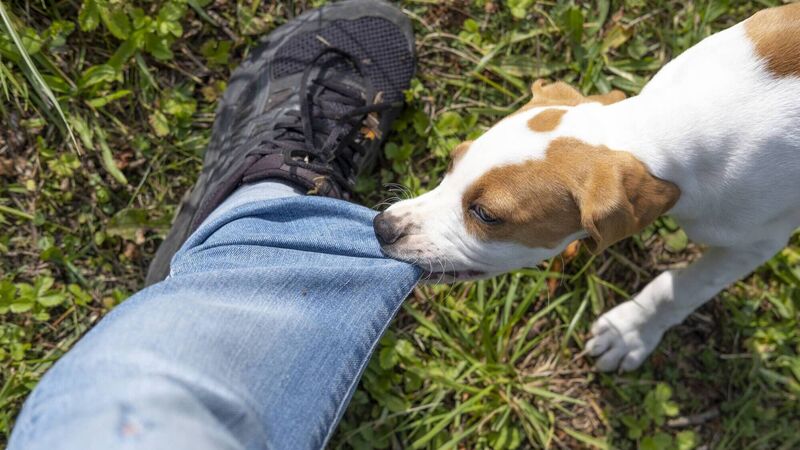Pete the Vet: How to make sure that you and your children are never bitten by a dog

Bites do happen, not always the breeds that you would expect
Dogs have never been more popular in Ireland. The stay-at-home aspect of the pandemic made dog ownership possible for many who had been unable to have a dog because they were working full time. Estimates suggest that there has been a surge in the dog population of 20% over the past year.
There are many benefits from dog ownership, especially for children and young people: a dog can be a helpful emotional anchor, and studies show that children that grow up with pets are likely to be more self confident and socially adept.
But dog ownership also carries some risks: dog attacks and dog bites only happen rarely, but the consequences can be serious, especially to young and vulnerable children. As well as physical injuries, children can suffer psychological scars, sometimes developing lifelong anxiety around dogs. The big question is this: why do some dogs “misbehave” like this, and what can be done to prevent dogs from biting?
The best answer is gleaned from a careful analysis of the facts. In 2008, a research paper, whose lead author was a Cork-based vet, analysed the background to 234 dog bite incidents in Ireland.
The researchers interviewed people who had been bitten by dogs, as well as the owners of the dogs. A biting incident was defined as any situation where "a visible mark was left on the victim's skin", so this included many minor bites that did not require medical treatment as well as more serious injuries and attacks.
Overall, 21 per cent of the incidents were rated as 'serious' and 2 per cent as 'life threatening'. One fifth of the dogs were euthanised as a result of the incident, paralleling the percentage of serious bites.
An analysis was carried out of each incident, and the results were collated to provide a useful resource which helps us to understand more about what can go wrong in the human-dog relationship. There are three main areas which have relevance for preventing dog bite incidents.
First, the study confirmed that common stereotypes about certain breeds of dog being more likely to bite are not true. The two dog types that were most commonly involved in bite incidents were collies and terriers, which also happen to be the two most popular breed types in Ireland.
The Staffordshire Bull Terrier was one of the least likely breeds to bite, while breeds that are normally seen as almost harmless (such as the Papillon and Pekingese) were in the top ten.
This is not to say that these two breeds are culpable in any way: the point is that it's wrong to focus on dog breed when considering how to prevent dog bites. In Ireland, current legislation means that eleven dog breeds (including Staffordshire Bull Terriers) are subject to specific restrictions (e.g. they are obliged to be muzzled in public).
The research suggests that this strategy should be reviewed: it may be more effective to change the laws to control specific individual dogs that have been involved in public safety incidents, rather than having wide ranging laws which are not based on science, and which are rarely enforced in any case.
For parents, the point is that all dog breeds can bite: it’s wrong to assume that you can keep your children safe just by buying a “family-friendly breed”.
Second, the research paper identified a strong relationship between encroaching on a dog's territory and bite incidents. In over 95% of the episodes, the person bitten was proactively engaging with the dog in some way, such as entering the dog's property, playing with the dog or trying to catch the dog.
In only 2.2% of cases, the victim was genuinely not doing anything connected with the dog. These facts highlight an important point: dog bites are very likely to be prompted by human behaviour. And consequently, if humans can learn more about how to interact safely with dogs, bites are far less likely to happen.
All new owners should engage with professional dog trainers to ensure that they are well informed about living with dogs. Clear boundaries in households, and regular one-to-one reward based training sessions between owners and dogs are important aspects of dog ownership.
The third important lesson is that the study showed that children are three to five times more likely than adults to be bitten by a dog. There are two main reasons for this.
a) Children are physically smaller and weaker than adults, so dogs naturally see them as easier targets, with a higher chance that the dog will come out better in any physical contest.
b) Children are more likely to accidentally provoke a dog to bite because of the way they interact with dogs. Children are less educated about dog behaviour, they don’t understand dog body language as well as adults, and, from a dog’s perspective, children are less controlled and less predictable. Adults realise that there are some things that you just don't do (such as putting your face close to a dog that’s eating its dinner), and adults also recognise the warning signs that dogs send out (such as growling or snarling).
The higher risk of children being bitten means that adults need to take special care to protect them from dog bites. Young children should never be left alone with dogs. Older children need to be specifically taught how to interact safely with dogs: there are some helpful online educational websites designed to do this.
Dogs are wonderful companions, and with some thinking, planning and action by humans, there is only a tiny risk to the people around them.






